What is an "aperture" ?
Aperture is referred to the lens diaphragm opening inside a photographic lens. The size of the diaphragm opening in a camera lens REGULATES amount of light passes through onto the film inside the camera the moment when the shutter curtain in camera opens during an exposure process. The size of an aperture in a lens can either be a fixed or the most popular form in an adjustable type (like an SLR camera). Aperture size is usually calibrated in f-numbers or f-stops. i.e. those little numbers engraved on the lens barrel like f22 (f/22),16 (f/16), f/11, f/8.0, f/5.6, f/4.0, f/2.8, f/2.0, f/1.8 etc. Each of this value represents one time the amount of light either more or less in quantity. Meaning to say, f/16 will let in 1X the amount of light than a diaphragm opening of f/22 and so forth; while on the other hand, an aperture of f/4.0 will let in 1X lesser than that of f/2.8 etc.

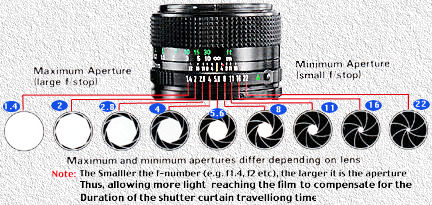
Note: the diaphragm blades inside this manual focus Canon FD lens control the amount of light passing through the lens that eventually hitting to the film during an exposure process. The 'amount', or simply explained in layman term - opening changes according to selection of aperture (f/number). In this case, it is indicated by the f-numbers that imprinted on the lens barrel.
These numbers engraved on the lens barrel are NOT referred to aperture diaphragm, but rather just a numeric settings which help to let you determine and control how much light you would require to let into the camera by way of selecting an aperture diaphragm (lens opening inside). Technically, these numbers refer to the relative physical opening of the lens diaphragmModern Autofocus SLR cameras may have a different ways in manipulating the aperture. One of the trend is - the aperture value is now control via a thumb wheel on the camera (usually near the shutter release button) and the AF lens has no aperture ring to alter the value. Each camera manufacturer usually has their own series of lenses under a trade name to verify its usage, various compatibility issues with their previous camera model's function etc. For an instance, Canon manual focus lenses are called "FD" or "FL"; while their newer series of autofocus lenses (AF) designed for their Canon EOS Series cameras are referred as "EF" (Electro Focus). Each of these MF/AF lenses has their own respective way to illustrate the control of aperture in the camera. When you turn the aperture ring on a lens to vary the aperture, you will be able to check visually the set opening of the lens diaphragm (Opens bigger or stopping smaller).
* here in this section, I am confining the discussion within the MANUAL FOCUS lenses ONLY because the proportion of used equipment forms the basis for a cheap, easy entry for potential new serious photographers.
* Some lenses such as those made by Canon (See above), the lens diaphragm will not react to turning, unless you press the aperture pin.
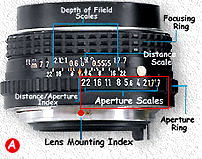 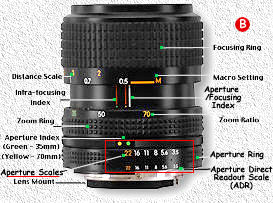 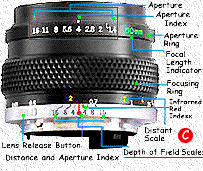
There are many camera brands out in the market, thus, it is indeed very difficult for me to compile all of the labels into a single site. Anyway, I am using three popular camera brands to illustrate the whereabouts of these aperture on the lens. (A) is a typical FA lens by Pentax; (B) is a typical manual focus Nikkor zoom lens from Nikon; while the (C) is a Zuiko lens by Olympus.
Reminder:- the key to an theoretical good EXPOSURE = Aperture + Shutter speed
| Aperture value(s): | f/64, f/32, f/22, f/16, f/11, f/8.0, f/5.6, f/4.0, f/2.8, f/2.0, f/1.8/f1.4 etc.
| Control via the lens section | | Shutter speed(s): | 1/8000, 1/4000, 1/2000, 1/1000, 1/500, 1/250, 1/125, 1/60, 1/30, 1/15, 1/8, 1/4, 1/2, 1 sec, etc. | Control via the Camera section |
Remember: For a theoretical "perfect"exposure to be formed i.e. nice colour balance, every details shown or simply a photo that you are happy about, take a good combination between using an aperture with the appropriate matching shutter speed for any given film speed (ASA/ISO) are required. The latter refers to the film speed of the film roll used. i.e. ASA 100, ASA 200, ASA 400 etc. the faster the film speed used, you can use to capture lower lighting situation but at the expense of grainer output of prints / slides. Next, a little confusion may create for you to learn here: - each step increment in the use of film speed will also indirectly correspond with one step of aperture OR shutter speed.
About aperture and its direct relation that might affect in your photography:- i.e. Other than controlling the amount of light entering into the camera, What else does "apertures" do ?
When the shutter button is released, light passes through the aperture diaphragm and hit the film, an exposure is formed. Basically, aperture, along with duration/timing of the shutter curtain opening, BOTH contribute to a the formation of an exposure. But aperture also affects an important photographic element called "depth of field" (short form "DOF"). You may ask, what is hell is this "Depth of Field" ? Depth of field is just technical term used to describe the 'zone' of sharpness' between nearest and furthest of a subject in focus (to be more exact, distance of sharp focus in front and behind, subject on which the lens is focused). There are a few elements that will affects Depth of Field in a picture
(Note:- Factors on lens ONLY, shutter speed never affects depth of field): | 1 | the lens opening (diaphragm inside the lens) | | the bigger the apertures used, the zone of sharpness is shallower or vice versa i.e. smaller aperture used will has extended depth of field | | 2 | the focal length of the lens (50mm as standard, 80mm above as telephoto; 35mm or shorter as wideangle) | | wide angle lenses have extended field of sharpness than a longer focal length telephoto lenses and/or longest reach focal length on your zoom lens), and | | 3 | the distance from the lens to the subject | | the nearer the subject is, the shallower the zone of sharpness and vice versa. |

Creative use of picture frame in composition and small aperture to gain maximum depth of field.
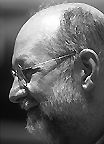
Shallow depth of field with combination of close focus with a telephoto lens and a fairly large aperture may limit the zone of sharpness to minimal.

Top and Bottom:- Typical scenic pictures with a smaller aperture to gain extended depth of field (sharp zone of focus)
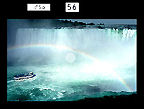

Lovely blur out (depth of field) on distracting background via use of a combination of telephoto lens with a large aperture which draws viewer attention to the main subject.
In fact, if you still don't understand, just memorize this: Other than it can be used to regulate amount of light entering into camera for an exposure, aperture also will affect the degree of depth of field. When combined with other essential elements that may also contribute to depth of field changes, such as focal length of the lens in use, the distance of your object in focus, you can make use of depth of field for creative control in your photography. For example: use larger aperture (Smaller number like f/2.8, f/2.0 etc.) with a long focal length to isolate or emphasis on expression, such as in portraiture photography; or use a smaller aperture (Bigger number like f/16 or f/22 etc..) to ensure pin-sharp details in both the foreground and the background.
Another factor you need to know is: All the markings on the lens barrel are double in effect . i.e. f/11 doubles the amount of light of f16, f2 allows 1X more light than of f2.8 does into the camera etc.
With a mechanical SLR camera, with the proper exposure GUIDE suggested by the built-in meter in a camera, you need to adjust both aperture and shutter speed yourself (it is termed as "MANUAL" setting in an automatic camera). Usually in the case of an automatic camera, you will still have manual control operating as if you are using a mechanical camera. Typically, a few extra choices of exposure control methods may be provided:- the first is called "Aperture Priority" (some camera uses a symbol "Av" - short for "aperture value"; the next is "Shutter Priority" (Tv - short for "Timing value". Aperture priority means you select the aperture to determine the depth of field yourself and the camera will set to the appropriate shutter speeds to match your aperture selected for a optimum exposure suggested by the camera's built-in electronic metering circuit, while shutter priority will let you select the preferred shutter speed setting and the camera will select the matching aperture values to match your choice. The third option is called the "Programmed Mode"(P - short for "Programmed Auto", where the camera select both the aperture value and the shutter speed for you and you may have no control in determine the depth of field yourself. (some cameras offer a another mode called flexi-program - I think it is too complicated to explain here).
Some examples of how an APERTURE PRIORITY AUTO SLR-type cameras shutter speed ring look like and comparison made with a fully mechanical SLR type (below - far right)
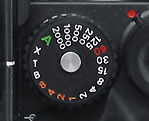
| 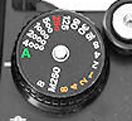
| 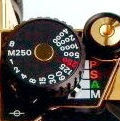
| 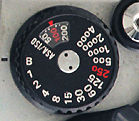
| | Nikon F3 Top Av auto SLR models of yesterdays: -Other examples are:
Pentax LX | Nikon FE2 Other examples like the Olympus OM2n and Canon AV-1 | Nikon FA
This is a Multi-modes auto SLR. The ring doesn't have an "A", various modes ae at the side P, S, A and M (Manual)
| Nikon FM2n The Shutter Speed ring of a MECHANICAL / NON-AUTO SLR. no Auto selection button or setting. You need to set the shutter speed on the camera section along with the aperture on the lens. Other brands such as Pentax offers K1000, Olympus has an OM-1 etc. |
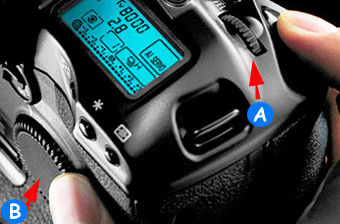 | Newer range of autofocus SLR cameras use a new method of controlling aperture. You will find there is NO NEED to set aperture via the lens aperture ring; instead - aperture is controlled by the thumb wheel for BOTH shutter Speed (B) and Aperture (A). A method first pioneered by Canon on their manual focus Camera, the Canon T90 back in 1986. Although this new electronic input method is different from older SLR cameras, the principle remains the same. The VISIBLE confirmation of the selected aperture used on camera like this type is via the LCD on the top panel OR through the viewfinder. |
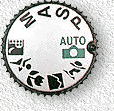 Note: An exposure control ring found in many modern SLR. The various setting may be represented by a few symbols/letters, "P" is for "Programmed AE", the "Tv" is for shutter priority while the Av (aperture value) is referring to aperture priority - Canon's way of interpreting in their A and T series camera bodies. IF you are a owner of one of those SLR cameras, you can find out the exact model you are using. While Nikon Owner may use THIS SECTION OR you may find the specific camera models that I might have developed with a featured section.
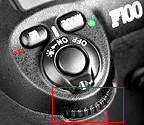 Every camera manufacturers have different design of how to adjust shutter speeds with a dedicated AF lens. For an example, Nikon's Nikon F5, 1996/7 finally followed Canon's path in using wheel input for shutter speed and aperture control; followed by its next generation AF film/digital-based SLRs which resulted in newer AF G-series Nikkor lenses now has NO aperture ring on the lens barrel for controlling aperture. However, if an older manual focus Ai lens is used in manual or aperture priority AE mode, it will still operate as an conventional SLR in which you will still make use of the lens aperture scales. Time changes, methods alter but basic principle remains.
[ 本帖最後由 carolfeeling 於 2007-12-19 11:58 PM 編輯 ] |




